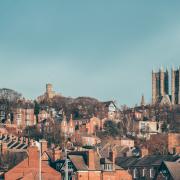Bluebells are growing like the clappers at this time of year. Clea Grady from Yorkshire Wildlife Trust suggests a few of the best places to see them.

There’s something magical about bluebells; the feeling that envelopes you when you walk into a woodland carpeted with flowers – the floor stretching before you, an everlasting sea of purple. Photographers flock to them, children look for pixies in them, and adults get engaged among them. It’s the stuff of fairy stories and we are all well and truly enchanted.
Like many of the things that catch our attention and spark our imagination, a bluebell’s life is brief and vivid. We may catch but a fleeting glimpse before they are gone for another year. As spring gets into its stride, one of Yorkshire’s most breath-taking natural spectacles is unfolding within our ancient woodlands as the bluebells burst into life. Discovering the secrets of this mysterious and beautiful flower is one of life’s purest and most simple pleasures, so be sure to get out and find them.
Bluebells can be found at nature reserves all across Yorkshire, from Hetchell Wood in Leeds and North Cliffe Woods near Market Weighton, to the smaller Moorlands Nature Reserve in York and even at Potteric Carr near Doncaster (Yorkshire Wildlife Trust’s largest site). One of the wild wonders of spring, May is the perfect time to spot bluebells in full bloom.
These pretty bell-shaped flowers have an age-old association with misfortune in folklore. Also known as ‘fairy flowers’, people believed fairies used bluebells to trap small children. It was considered terribly unlucky to pick one or bring even a single flower into the house, and if you heard a bluebell ‘ringing’ then it was a signal from the fairies of imminent death. It was also believed that wearing a wreath of bluebells would be compel you to speak only the truth, and if you could turn the flowers inside out without tearing them then you would eventually find true love. A symbol of constancy, it is also thought the bluebell was the original ‘something blue’ in the well-known wedding day tradition.

Nowadays, it is hard to think of a more spirit-lifting sight than a carpet of bluebells in springtime. In addition to being beautiful to look at, they are also hugely important for the bees, hoverflies and butterflies who feed on their nectar before other flowers have emerged. They are their early spring food. And because of their slow spread rate, it is also thought that bluebells could hold the clue to the location of our ancient woodlands. Finding bluebells in a hedgerow or back garden means there is a possibility it once was a site of woodland dating as far back as the last ice age. Luckily for us, however, we don’t need to travel back in time to experience their wonder. Half of the world’s bluebell population resides in the UK and Yorkshire Wildlife Trust has many ancient woodland nature reserves where you can easily spot them (all reserves are listed on ywt.org.uk.)
One part of Yorkshire where they are particularly abundant is the Yorkshire Nature Triangle; an area of East Yorkshire where wildlife and wild places are prolific. This geographical ‘triangle’ combines the world-class natural encounters with a warm local welcome and runs from Scarborough to Hull, and across the Humber and the Wolds. Here you will find woodlands just perfect for family explorations, springtime picnics and, of course, bluebell spotting.
Not far from Pocklington is Millington Wood. Described as the richest botanical woodland in the region, it is also one of the best ancient ash woods in the Yorkshire Wolds. In mid-spring, you will find bluebells by the hundreds and you may also see barn and tawny owls, as well as roe deer. Easy accessible, Millington Wood is one of those places where you can spend an hour or an entire day, so pop a pack-up in your bag if the sun’s shining and take the time to soak it all in.
North Cliffe Wood is a lovely woodland nature reserve that’s also rich in wildlife. At this time of year, a lilac haze of bluebells stretches out beneath the vibrant green leaves of birch, and the songs of warblers fill the air. Close to Market Weighton, children will also be delighted by the Hebridean sheep who graze the land in the spring.
Walkers and fans of the outdoors will revel in the beauty of Brantingham Dale. Here you can enjoy magnificent views and woodland paths and embark on an invigorating eight-mile walk from Brantingham Village. Go to walkingtheriding.eastriding.gov.uk for details..
Outside of the Triangle, bluebells are still within easy reach – even for city dwellers. Doncaster residents are lucky to have Yorkshire Wildlife Trust’s largest reserve on their doorstep. A brilliant wildlife-rich experience at any time of the year, Potteric Carr also plays host to these magic flowers.
Over in West Yorkshire, one visit to Hetchell Wood and you’ll be enthralled. Its beauty is captivating and the woodland paths allow for exploration of a landscape which appears locked in times gone by. go and lose yourself among the bluebells.
For social media fans among you, few backdrops can rival a profusion of bluebells so now’s the time to get those romantic couple selfies on Instagram.
Please remember that bluebells are a protected species in the UK, so please do not dig them up or pick them.
6 places to view bluebells in Yorkshire
12 photos that capture the true beauty of bluebells in Yorkshire
West Yorkshire walk - Ilkley and Middleton Woods bluebells
Clumps of bluebells and wild garlic can give your garden a lovely woodland atmosphere



























